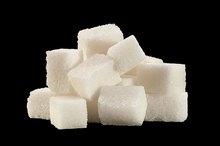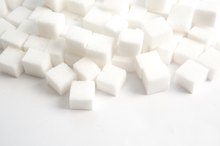What does fact checked mean?
At Healthfully, we strive to deliver objective content that is accurate and up-to-date. Our team periodically reviews articles in order to ensure content quality. The sources cited below consist of evidence from peer-reviewed journals, prominent medical organizations, academic associations, and government data.
The information contained on this site is for informational purposes only, and should not be used as a substitute for the advice of a professional health care provider. Please check with the appropriate physician regarding health questions and concerns. Although we strive to deliver accurate and up-to-date information, no guarantee to that effect is made.
Three Types of Sugars
Sugars are naturally occurring carbohydrates, and the simplest kind of carbohydrate. Sugars are a source of energy for your cells, form part of larger, more complex molecules, and provide energy storage. Since your body quickly digests sugars, they also provide you with a quick source of energy. There are three types of sugars.
Monosaccharides
Monosaccharides are simple sugars, meaning they have only three to seven carbon atoms arranged in either a chain or ring structure. The ‘mono’ stands for one, and signifies that monosaccharides only have one ring. Two kinds of monosaccharides include glucose and fructose. Glucose is the most important monosaccharide in nature; it is the main source of energy for body cells and is present in most sweet fruits, as well as in your blood. Fructose is the sweetest monosaccharide, present in fruits and honey.
- Monosaccharides are simple sugars, meaning they have only three to seven carbon atoms arranged in either a chain or ring structure.
- Fructose is the sweetest monosaccharide, present in fruits and honey.
Disaccharides
Fructose Vs. Sucrose
Learn More
Disaccharides are two simple sugars linked together in a double ring. Your body must break down disaccharides, just like any carbohydrate other than monosaccharides, before you can get energy from them. Maltose is a disaccharide. It consists of two glucose molecules, while sucrose consists of glucose and fructose.
- Disaccharides are two simple sugars linked together in a double ring.
- It consists of two glucose molecules, while sucrose consists of glucose and fructose.
Polysaccharides
Polysaccharides are large chains of simple sugars, consisting of many monosaccharides. Examples of polysaccharides include starch and glycogen, both of which consist of hundreds of glucose units and different types of bonds holding them together. Polysaccharides serve two main functions: storing energy that your body can use when external food supply is low and providing structural support and protection.
Simple and Complex Carbs
List of Sugars & Starches
Learn More
Monosaccharides and disaccharides are simple carbohydrates, while polysaccharides are complex carbohydrates. Simple carbohydrates are present mainly in fruits and milk, as well as in high-sugar foods like candy and sweets. Complex carbohydrates are in legumes, grains and starchy vegetables like potatoes, peas and corn. The National Institutes of Health suggests eating more complex carbohydrates, especially whole grains and beans, while limiting sugars from candy and sweets, which have little or no nutritional value 5.
- Monosaccharides and disaccharides are simple carbohydrates, while polysaccharides are complex carbohydrates.
- Simple carbohydrates are present mainly in fruits and milk, as well as in high-sugar foods like candy and sweets.
Related Articles
References
- Healing Nutrition; L Keegan
- Burton's Microbiology for the Health Sciences, North American Edition; PG Engelkirk, J Duben-Engelkirk
- Anatomy and Physiology; F Martini
- Foundations & Clinical Applications of Nutrition: A Nursing Approach
- National Institutes of Health: MedlinePlus: Carbohydrates
- Carr, T. P., Gropper, S. S., Smith, J. L. (2016). Advanced Nutrition and Human Metabolism. United States: Cengage Learning.
- U.S. Department of Health and Human Services and U.S. Department of Agriculture. 2015–2020 Dietary Guidelines for Americans. 8th Edition. Published December 2015.
Writer Bio
Since 2009 Jessica Benzaquen has published research articles and abstracts in “Pharmacology, Biochemistry & Behavior” and “The Society for Neuroscience Meeting Planner.” After receiving her Bachelor of Arts and Science degree in neuroscience and cognitive neuropsychology at the University of Guelph, she earned her Master of Science degree in neuroscience at the University of Western Ontario while investigating possible environmental triggers for autism.









